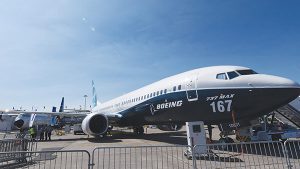Bloomberg
For Boeing Co., the pandemic was just one item on the long list of its existential concerns over the past four years. But after a talent exodus, the twin tragedies of its 737 Max jets falling from the sky, and stiff competition from rivals (on top of Covid’s blow to air travel), the company is gearing up for a production resurgence that will help mount the industry’s steepest ramp-up in modern aviation history.
The comeback rides on whether a Boeing factory south of Seattle can pump out 31 of its cash cow Max jets each month, a 63% jump from its pace in October. The breakneck acceleration is already underway at a time when rival Airbus SE is also pushing the pedal to the floor. And then the real challenge will be to keep steadily moving higher.
But Boeing can’t do it alone. The risk is that the constellation of suppliers that ship millions of parts to planemakers and enginemakers won’t be able to hire enough workers to keep pace. Those smaller manufacturers are facing labor shortages two years after US aerospace companies jettisoned 57,000 employees. Already at the current low production pace, there are signs of stress and spot shortages. With an industry upturn looming, the crunch looks poised to get much worse.
Even after all the adversities Boeing has faced, “the next 18 months is more risky than the prior 18,†said Kevin Michaels, managing director of consultant AeroDynamic Advisory. Whether aviation’s titans hit their lofty output targets “will be determined by the supply chain’s ability to execute and finance growth,” he said.
If the labor squeeze means Boeing can’t get the parts it needs, timed precisely to its production process, the company risks not only costly logjams but also the prospect of churning out scads of partially completed planes. Supplier disruptions famously forced Boeing to shutter production in 1997 and later left dozens of “ gliders†— jets lacking engines — stacked up around the Renton, Washington, plant during the last ramp-up in 2018.
About two-thirds of suppliers surveyed by RBC Capital Markets say the ability to staff up is the biggest risk to the aerospace recovery. Michaels estimates worker shortfalls of 10% to 20% are common. Concerns are particularly high for two foundries, Howmet Aerospace Inc. and Warren Buffett-owned Precision Castparts Corp., which produce the lion’s share of highly complex jet-engine components, like turbine blades able to withstand blast-furnace temperatures. The companies reduced headcount by 17% and 40% respectively during the downturn.
Worker shortages are endemic in corporate America — from fast-food outlets to auto plants — but it’s an incredibly challenging problem to fill highly skilled jobs in aerospace. Trades like precision machinists require apprenticeships and years of specialized training before workers are deemed qualified.
Raytheon Technologies Corp., which builds Pratt and Whitney jet engines for Airbus and components for Boeing, is already seeing a worrisome shortage of welders at casting companies in its supply chain. Of the manufacturer’s 13,000 component providers, there fewer than 100 companies “that are giving us real concern. But it only takes one to make us miss a shipment,’’ Chief Executive Officer Greg Hayes said on an earnings call.
 The Gulf Time Newspaper One of the finest business newspapers in the UAE brought to you by our professional writers and editors.
The Gulf Time Newspaper One of the finest business newspapers in the UAE brought to you by our professional writers and editors.
